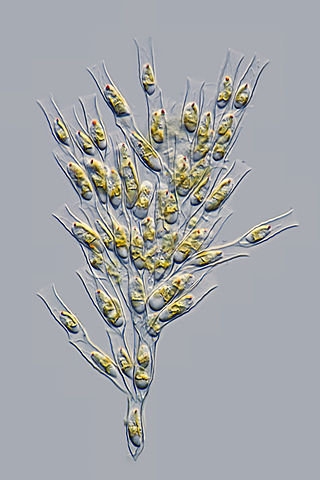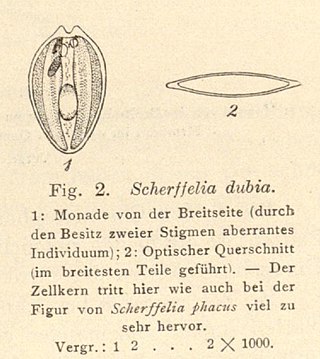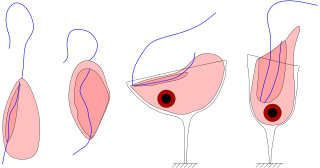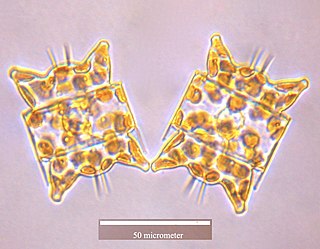Cryptomonas is the name-giving genus of the Cryptomonads established by German biologist Christian Gottfried Ehrenberg in 1831. The algae are common in freshwater habitats and brackish water worldwide and often form blooms in greater depths of lakes. The cells are usually brownish or greenish in color and are characteristic of having a slit-like furrow at the anterior. They are not known to produce any toxins. They are used to feed small zooplankton, which is the food source for small fish in fish farms. Many species of Cryptomonas can only be identified by DNA sequencing. Cryptomonas can be found in several marine ecosystems in Australia and South Korea.

Chromulinales is an order of Chrysophyceae, golden-brown algae or golden algae. It was first identified and defined by Adolf Pascher (1881–1945) in 1910.

Yellow-green algae or the Xanthophyceae (xanthophytes) are an important group of heterokont algae. Most live in fresh water, but some are found in marine and soil habitats. They vary from single-celled flagellates to simple colonial and filamentous forms. Xanthophyte chloroplasts contain the photosynthetic pigments chlorophyll a, chlorophyll c, β-carotene, and the carotenoid diadinoxanthin. Unlike other Stramenopiles (heterokonts), their chloroplasts do not contain fucoxanthin, which accounts for their lighter colour. Their storage polysaccharide is chrysolaminarin. Xanthophyte cell walls are produced of cellulose and hemicellulose. They appear to be the closest relatives of the brown algae.

Hemimastigophora is a group of single-celled eukaryotic organisms including the Spironematellidae, first identified in 1988, and the Paramastigidae. Over the next 30 years, different authors proposed placing these organisms in various branches of the eukaryotes. In 2018 Lax et al. reported the first genetic information for Spironemidae, and suggest that they are from an ancient lineage of eukaryotes which constitute a separate clade from all other eukaryotic kingdoms. It may be related to the Telonemia.

Spironematellidae is a family of heterotrophic flagellates, in the group Hemimastigophora. They vary in size and shape from the ellipsoid Hemimastix amphikineta to the vermiform Spironematella terricola, and are united by the possession of two rows of cilia, called kineties.

Synechococcus is a unicellular cyanobacterium that is very widespread in the marine environment. Its size varies from 0.8 to 1.5 μm. The photosynthetic coccoid cells are preferentially found in well–lit surface waters where it can be very abundant. Many freshwater species of Synechococcus have also been described.

The raphidophytes, formally known as Raphidophycidae or Raphidophyceae, are a small group of eukaryotic algae that includes both marine and freshwater species. All raphidophytes are unicellular, with large cells, but no cell walls. Raphidophytes possess a pair of flagella, organised such that both originate from the same invagination. One flagellum points forwards, and is covered in hair-like mastigonemes, while the other points backwards across the cell surface, lying within a ventral groove. Raphidophytes contain numerous ellipsoid chloroplasts, which contain chlorophylls a, c1 and c2. They also make use of accessory pigments including β-carotene and diadinoxanthin. Unlike other heterokontophytes, raphidophytes do not possess the photoreceptive organelle typical of this group.

Chlamydomonadaceae is a family of algae within the order Chlamydomonadales. Traditionally, it has been defined as containing single-celled flagellates with a cell wall.
Oocystaceae is a family of green algae, in the order Chlorellales. The type genus is Oocystis.

Paulschulzia is a genus of green algae, specifically of the family Tetrasporaceae.

Scherffelia is a genus of green algae in the family Chlorodendraceae.

Scourfieldia is a genus of green algae in the family Scourfieldiaceae. Cardiomonas Korshikov is an invalid synonym.

Bacteriastrum is a genus of diatoms in family Chaetocerotaceae. There are more than 30 described species in genus Bacteriastrum, but many of these are not currently accepted, and new species are still added to the genus. The type species for the genus is Bacteriastrum furcatum Shadbolt.

Jakobids are an order of free-living, heterotrophic, flagellar eukaryotes in the supergroup Excavata. They are small, and can be found in aerobic and anaerobic environments. The order Jakobida, believed to be monophyletic, consists of only twenty species at present, and was classified as a group in 1993. There is ongoing research into the mitochondrial genomes of jakobids, which are unusually large and bacteria-like, evidence that jakobids may be important to the evolutionary history of eukaryotes.

Odontella is a genus of marine diatoms. Some sources place it in the family Triceratiaceae, others in the family Odontellaceae. It contains the following species:
Sirodotia Kylin (1912) is a genus of freshwater red alga which was described by Kylin in 1912, and placed in the Batrachospermaceae family.

Chrysococcus is a genus of golden algae in the family Dinobryaceae.
Petalomonas is a genus of phagotrophic, flagellated euglenoids. Phagotrophic euglenoids are one of the most important forms of flagellates in benthic aquatic systems, playing an important role in microbial food webs. The traits that distinguish this particular genus are highly variable, especially at higher taxa. However, general characteristics such as a rigid cell shape and single emergent flagellum can describe the species among this genus.
Heteronema is a genus of phagotrophic, flagellated euglenoids that are most widely distributed in fresh water environments. This genus consists of two very distinguishable morphogroups that are phylogenetically closely related. These morphogroups are deciphered based on shape, locomotion and other ultrastructural traits. However, this genus does impose taxonomic problems due to the varying historical descriptions of Heteronema species and its similarity to the genus Paranema. The species H. exaratum, was the first heteronemid with a skidding motion to be sequenced, which led to the discovery that it was not closely related to H. scaphrum, contrary to what was previously assumed, but instead to a sister group of primary osmotrophs. This suggests that skidding heteronemids can also be distinguished phylogenetically, being more closely related to Anisoma, Dinema and Aphageae, than to other species within Heteronema.
Ochromonadales is an order of single-celled algae belonging to the class Chrysophyceae, also known as golden algae. Species of this order are flagellates, composed of cells capable of swimming by using two flagella. Though ancestrally photosynthetic, some species have secondarily lost this ability, and appear colourless. These are heterotrophic, and can be phagotrophic. Some are mixotrophic, capable of both photosynthesis and phagotrophy, such as Poterioomonas and Ochromonas.













